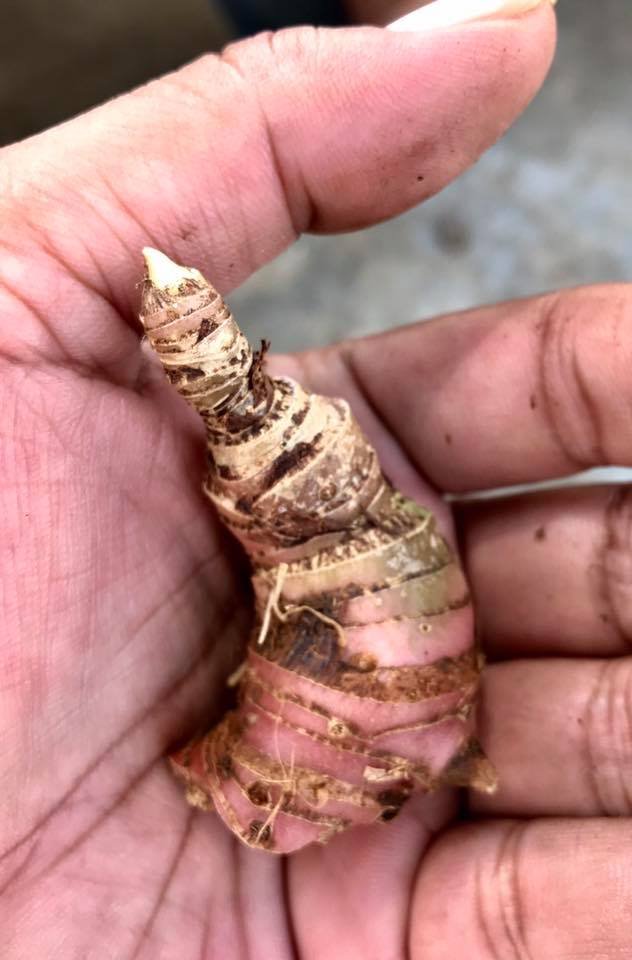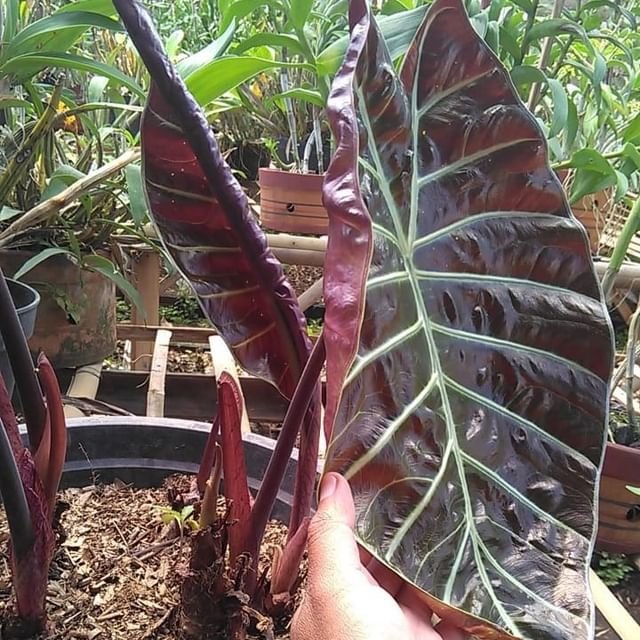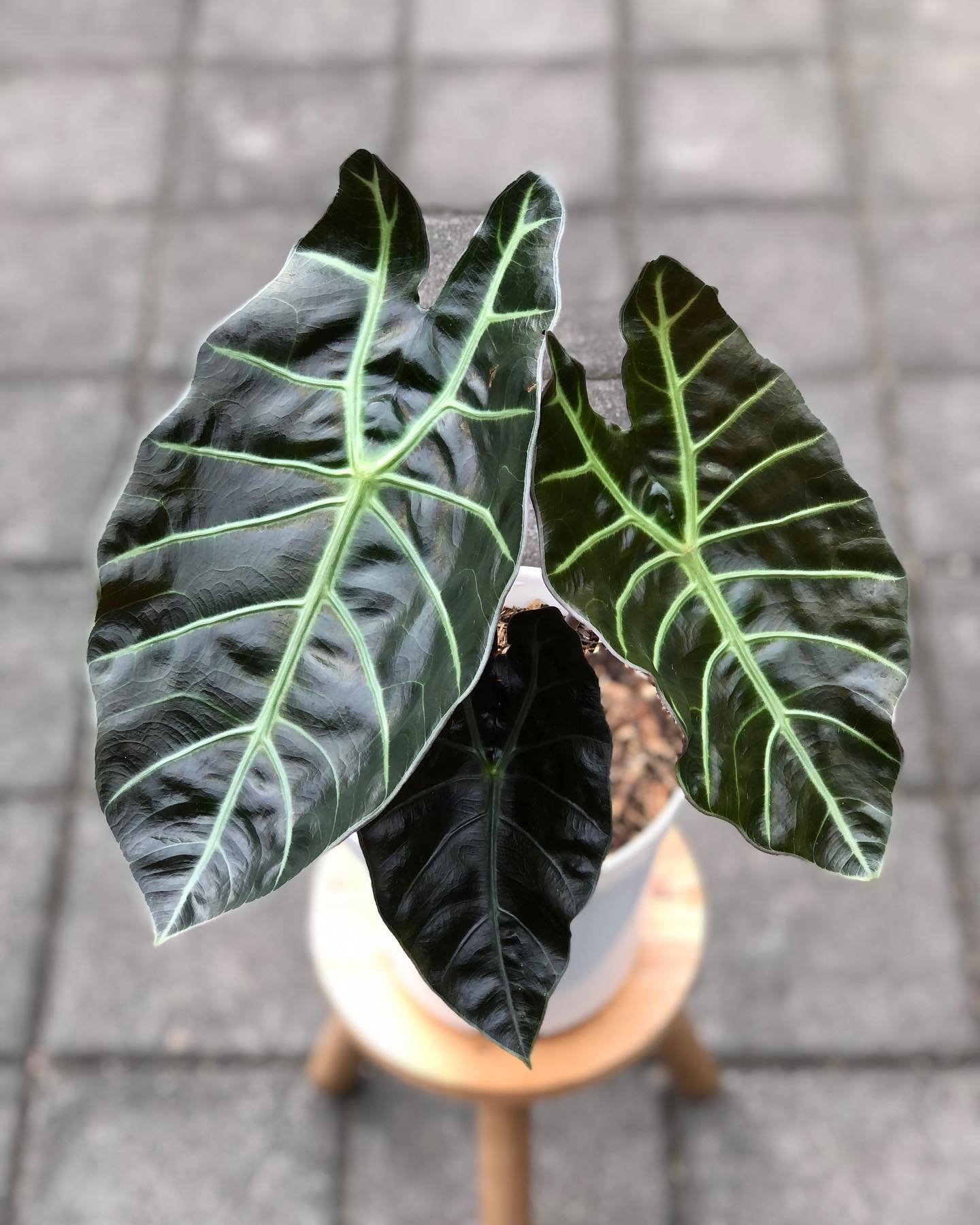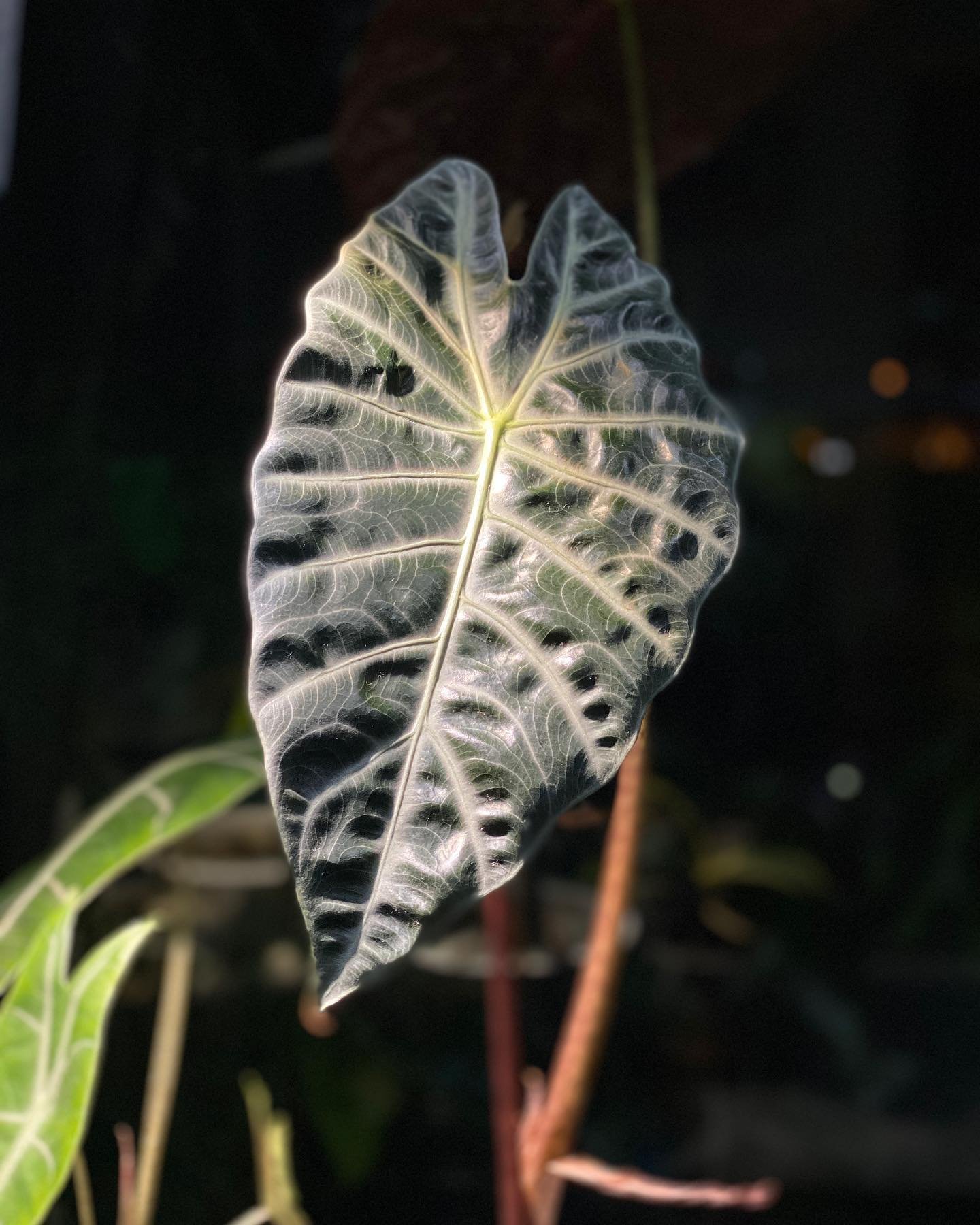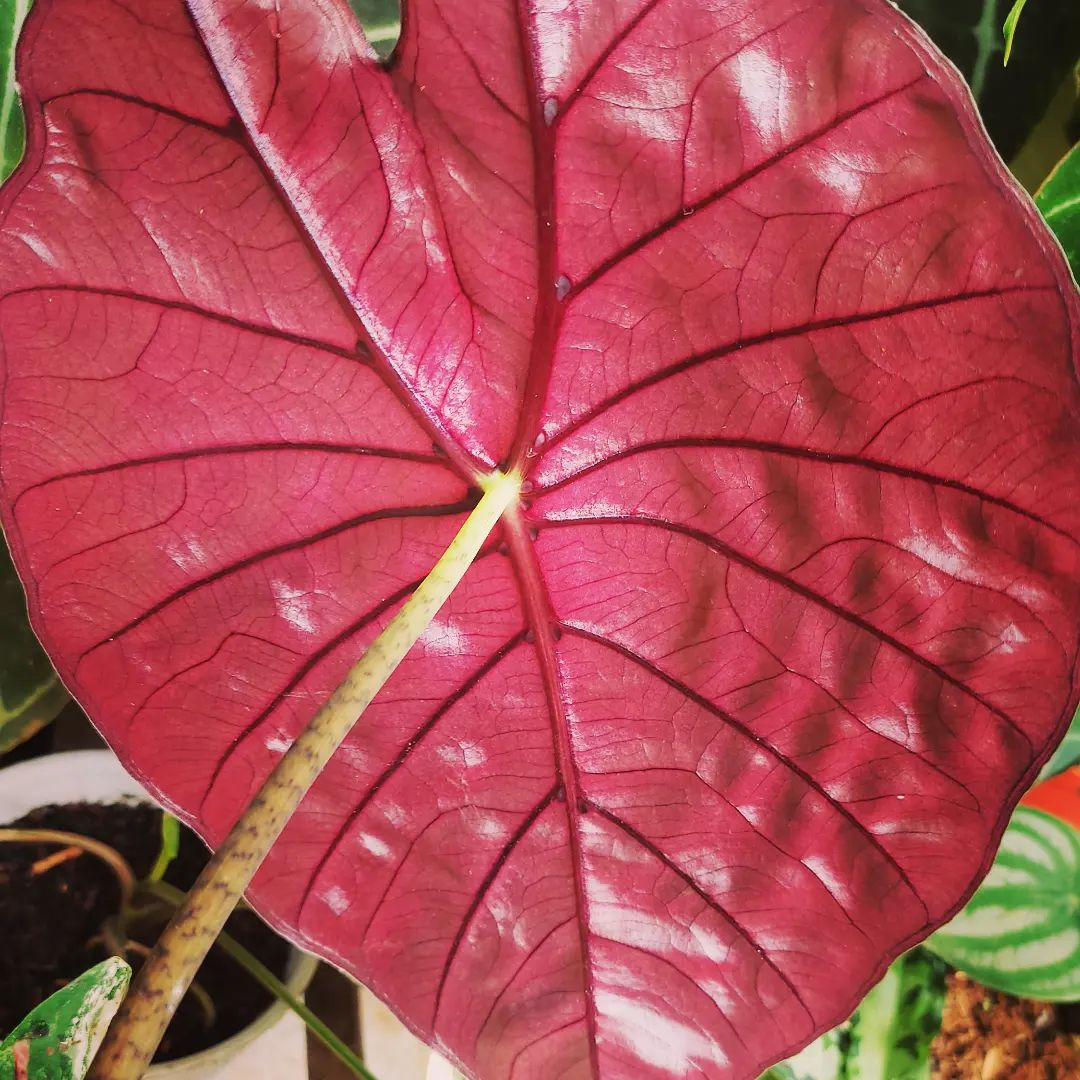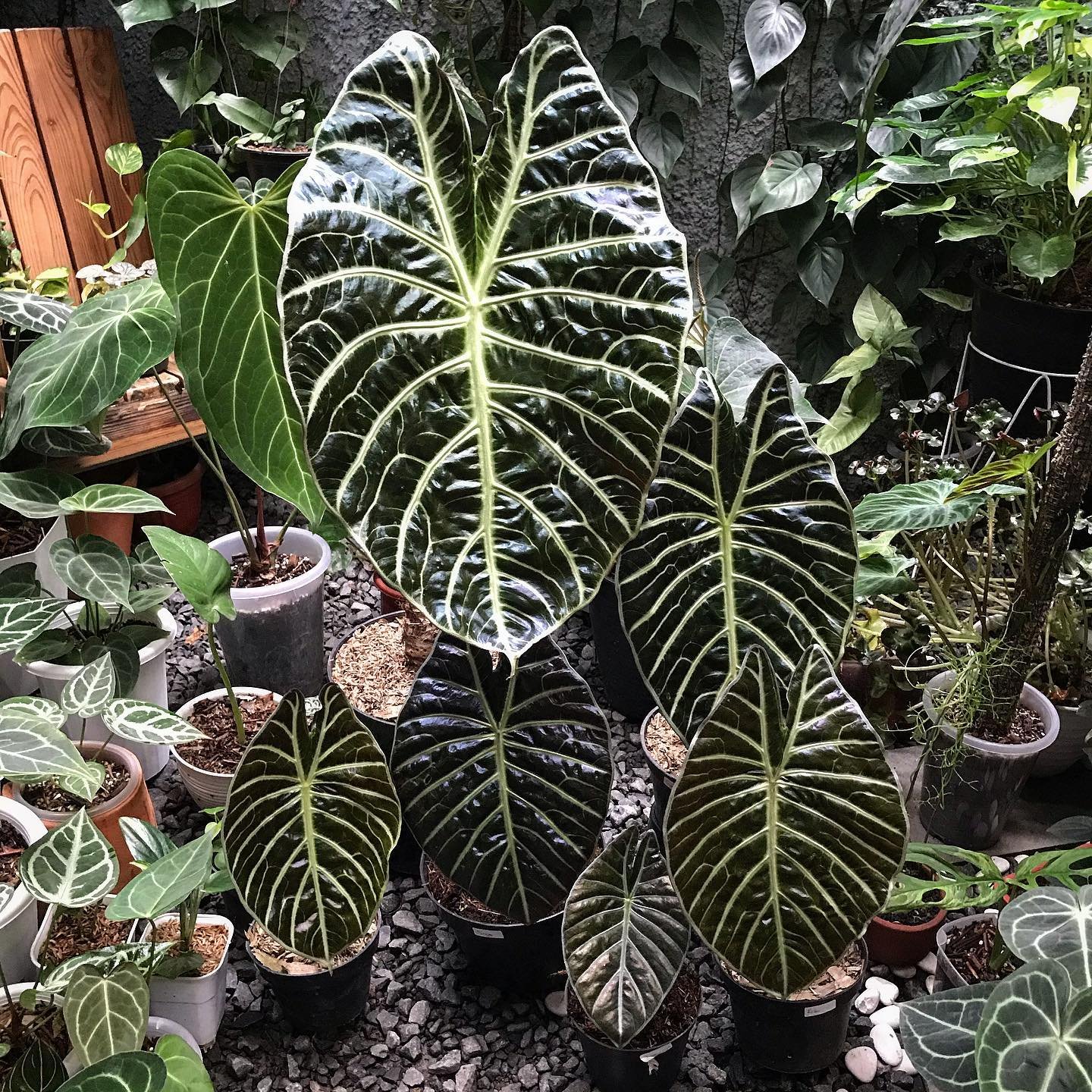ALOCASIA SUHIRMANIANA
ORIGINAL DESCRIPTION:
Ab Alocasia longiloba sens, latiss. petiolo puberulo, spathae lamina extus atropurpurea,
stigmatis rotunde lobatis, synconnectivis ad tnargines leviter expansis differt.
Typus: Indonesia: cultivated Kebun Raya, Bogor, ex S.E. Sulawesi, Kabupaten Kolaka,
Yuzammi s.n., 23 June 1997 (holo BO; photo NSW).
Telopea: Journal of Plant Systematics V.7 No.4 P..303 (1998)
Photo by GreenPlantsBali
SYNONYMS: N/A
DISTRIBUTION: Distribution: Indonesia, SE Sulawesi, known only from the type locality and Tolala.
CLIMATE: Tropical humid climate
Humidity is moderate throughout the year, ranging from 60% to 70%
Temperature is varies between the seasons - within the range of 48°F/9°C to 88°F/31°C during the day. Minimum temperatures never dip below 45°F/7°C
Rainy and humid season (October to May) and a dry season between June and October. The average annual rainfall is 1,200 mm
ECOLOGY: Damp shady spots in lowland rainforest on slopes. Kjellberg 2428 on limestone at sea level.
SPECIES DESCRIPTION:
Terrestrial herb; rhizome 13-15 cm long; leaves 1 to 3 together; petiole to c. 60 cm long, sheathing in the lower c. Vs -A , yellowish green, densely longitudinally and obliquely mottled purple-brown, minutely and densely puberulous, subtended by papery membranous cataphylls; blade broadly ovato-sagittate (shield-shaped), peltate, pointed down, thinly leathery, with the margin slightly undulate, glossy dark green adaxially with the major venation pale grey-green, dark purple abaxially; anterior lobe to c. 35 cm long x 10-24 cm wide, widest about 'A of the way distally from the junction with the petiole, the tip broadly acute to obtuse, shortly apiculate; anterior costa with up to 8 primary lateral veins on either side, the proximal ones diverging at 70-80°, the distal ones at c. 45°, with conspicuous purple glands in their axils abaxially; primary veins of anterior lobe each with 1-3 subsidiary veins thicker than, but running the
same course as, the secondary venation; secondary venation inconspicuous, forming undulating intercostal collective veins; costae and primary veins prominent both adaxially and abaxially; posterior costae diverging at c. 35—45°; posterior lobes about 1/2 to 2/3 the length of the anterior, joined for c. 1/2 to 2/3 of their their length, the tips acutely rounded.
INFLORESCENCE:
Inflorescences paired, subtended by papery membranous cataphylls to c. 11 cm long; peduncle to 24 cm long; minutely puberulous in the upper part, purple brown; spathe c. 12.5 cm long, deep purple, slender, glabrous, abruptly constricted at c. 2 cm from the base; lower spathe subcylindric; limb narrowly
lanceolate; spadix somewhat shorter than spathe, c. 10 cm long, slender, very shortly stipitate for 4 mm, stipe ivory; female zone c. 1.2 cm long, c.l cm wide at the base, with c. 96 pistils; ovaries greenish yellow, unilocular; stigma bluntly 2-4-lobed, subsessile, yellow; interstice of sterile organs c. 0.5 cm long, narrowed level with the spathe constriction to c. 4 mm diam.; lowermost synandrodia strongly lobed, the rest rhombohexagonal, c. 1.5 mm diam.; male zone c. 2 cm long, 1 cm diameter, cylindric; synandria rhobohexagonal, the tops deeply impressed, c. 2 mm across, yellowish ivory; thecae opening by apical pores laterally displaced by lobed overgrowth of the synconnective; appendix c. 6 cm, 8 mm diameter at the base, yellowish, the interface with the male zone slightly constricted, the rest cylindric, somewhat rugose in the lower half, tapering in the upper third; fruit reddish-orange.
VARIEGATED FORMS: YELLOW
ETYMOLOGY: The specific epithet for this species is a dedication to Dr. Ir. Suhirman, formerly Director of the Indonesian Botanic Gardens, who has done much to support botanical exploration and conservation in Indonesia.
NOTES:
Alocasia suhirmaniana is a member of the Alocasia longiloba group, which is characterised by a strongly rhythmic growth pattern, with a pronounced delay between flowering and resumption of leaf-production; thinly membranous cataphylls, degrading into rather sparse fibres; mostly peltate leaves, often purple-backed, often with white major venation, solitary or few together; spadix stipitate; stipe white; ovaries green with white to yellowish usually acutely lobed stigmas; the sterile interstice attenuate and corresponding with the spathe constriction; male zone ivory to yellowish ivory; synandria with the thecae not overtopped by synconnective; appendix pale orange-pink to yellow, occasionally ivory.
The Alocasia longiloba group includes, in addition to Alocasia suhirmaniana, Alocasia sanderiana and a
number of incompletely delineable 'species' currently being reduced to informal entities in the Indochinese and West Malesian Alocasia longiloba complex (Hay, in prep.). In addition, an inadequately known, as yet unnamed, Philippine element may represent a fourth circumscribable species in this group (Hay, in prep.).
Alocasia suhirmaniana is nearest in leaf shape and color to Alocasia longiloba 'Watsoniana' (syn.
Alocasia watsoniana Mast.), a Bornean, Sumatran and Malay Peninsula variant in the taxonomically intractable A. longiloba complex. The new species differs mainly in theundulate (vs strongly zig-zag) intercostal collective veins, the puberulent (vs glabrous) petiole, the flat to irregularly bullate leaf blade (vs bullate in a concentric pattern around the petiole insertion) and the straight posterior costae (vs pedately in-curved).With the exception of the puberulent petiole, which is unique in this species group, the
leaf is somewhat intermediate between Alocasia longiloba 'Watsoniana' and Bornean Alocasia longiloba 'Korthalsii' (syn. Alocasia korthalsii Schott), though significantly larger than the latter and distinguished by the frequent production of subsidiary veins (sporadically distributed veins following the course of secondary veins, but intermediate in thickness between the primary and secondary venation).
In reproductive features Alocasia suhirmaniana differs from all other members of the Alocasia longiloba group in the deep purple colour of the spathe. This feature is not infrequent in Araceae, generally associated with saproentomophily, but very rare in Alocasia, being known only in some populations of Bornean Alocasia robusta and Alocasia reginae, and Philippine Alocasia atropurpurea.
The stigmas in Alocasia suhirmaniana have rather blunt lobes whereas they are generally distinctly acute in
the group; however, the specimen from which the description has been prepared had not attained anthesis and the stigmatic lobes may not be fully developed. The tops of the synandria are deeply impressed with the marginal portions of the synconnective somewhat extended so that the pores of the thecae are slightly deflected, where they are more usually flat-topped with the pores facing upwards in the Alocasia longiloba group.
Several species in other parts of the genus Alocasia have puberulent petioles, including Alocasia puber (Java to Malay Peninsula), closely allied Alocasia macquilingensis (Philippines) and Bornean Alocasia sarawakensis (the latter in juveniles only).
Hairy leaves are also known in some Sumatran individuals of Alocasia puber, Alocasia arifolia, Alocasia chienlii and some individuals of New Guinean Alocasia nicolsonii
While hairs are usually tapared and pointed, those of Alocasia suhirmaniana are generally blunt and very short and so small as to be almost invisible to the naked eye, except as a fine velvety bloom.
Other specimens seen: Cult. RBG Sydney, Acc. No. 970541, propagated from material cultivated at Kebun Raya, Bogor, Hay 14006 (voucher NSW); SE Sulawesi, Tolala, Kjellberg 2428 (BO).
CULTIVARS: N/A
HYBRIDS: N/A





